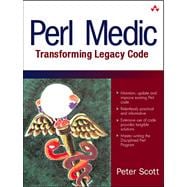- Cure whatever ails your Perl code!
- Maintain, optimize, and scale any Perl software... whether you wrote it or not
- Perl software engineering best practices for enterprise environments
- Includes case studies and code in a fun-to-read format
- Scale existing Perl code to serve larger network, Web, enterprise, or e-commerce applications
- Rewrite, restructure, and upgrade any Perl program for improved performance
- Bring standards and best practices to your entire library of Perl software
- Organize Perl code into modules and components that are easier to reuse
- Upgrade code written for earlier versions of Perl
- Write and execute better tests for your software...or anyone else's
- Use Perl in team-based, methodology-driven environments
- Document your Perl code more effectively and efficiently
If you've ever inherited Perl code that's hard to maintain, if you write Perl code others will read, if you want to write code that'll be easier for you to maintain, the book that comes to your rescue is Perl Medic.
If you code in Perl, you need to read this book.
–Adam Turoff, Technical Editor, The Perl Review.
Perl Medic is more than a book. It is a well-crafted strategy for approaching, updating, and furthering the cause of inherited Perl programs.
–Allen Wyke, co-author of several computer books including JavaScript Unleashed and Pure JavaScript.
Scott's explanations of complex material are smooth and deceptively simple. He knows his subject matter and his craft-he makes it look easy. Scott remains relentless practical-even the 'Analysis' chapter is filled with code and tests to run.
–Dan Livingston, author of several computer books including Advanced Flash 5: Actionscript in Action








